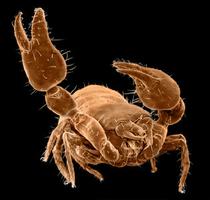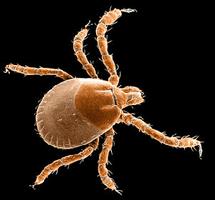Arachnida
Arachnida is a large class of chelicerate arthropods (segmented, jointed-limbed animals) including the orders Araneae (spiders), Scorpiones (scorpions), Opiliones (harvestmen), Pseudoscorpiones (pseudoscorpions), Solifugae (wind-scorpions) and the subclass Acari (mites and ticks). Second only to insects in species numbers, an estimated one million arachnid species may occur worldwide, about 13 000 in Canada. The great majority are mites; spiders are next most common.
Characteristically, arachnids have 2 body parts, the prosoma (cephalothorax) and opisthosoma (abdomen). The prosoma has 2 pairs of mouthparts, 4 pairs of legs, and, if present, 2-8 simple eyes above the first 2 pairs of legs. The opisthosoma has the genital and anal openings as well as various organs (eg, pectines of the scorpions and spinnerets of spiders). The Acari have diverged from this basic plan in having a movable headlike anterior body region, the gnathosoma, which bears the mouthparts and is distinct from the rest of the body. Arachnids lack wings.
Arachnids are an ancient lineage: the earliest known fossils are of 420 million-year-old scorpions. All major living groups had originated by the end of the Devonian age, 360 million years ago.
Mites, spiders and harvestmen occur throughout most of Canada. Some mites and spiders and one species of harvestmen even occur in the High Arctic. Ticks and pseudoscorpions are transcontinental north to the treeline, excluding arctic regions. Scorpions and wind-scorpions live only in southernmost western Canadian desert areas.
Most arachnids are predators of other arthropods, although some harvestmen feed on dead organic matter; ticks are obligate blood feeders (parasites) of vertebrates, and mites have diverse feeding habits.

 Share on Facebook
Share on Facebook Share on X
Share on X Share by Email
Share by Email Share on Google Classroom
Share on Google Classroom






